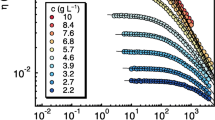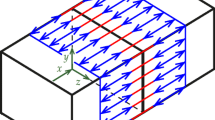Abstract
We focus on the linear viscoelastic response of heterogeneous nematic polymers to small amplitude oscillatory shear, paying special attention to the macroscopic influence of strong plate anchoring conditions. The model consists of the Stokes hydrodynamic equations with viscous and nematic stresses, coupled to orientational dynamics and structure driven by the flow gradient, an excluded-volume potential, and a two-constant distortional elasticity potential. We show that the dynamical response simplifies when plate anchoring is either tangential or homeotropic, recovering explicitly solvable Leslie–Ericksen–Frank behavior together with weakly varying order parameters across the plate gap. With these plate conditions, we establish “model consistency” so that all experimental driving conditions (plate-controlled velocity [strain] or shear stress, imposed oscillatory pressure) yield identical dynamic moduli for the same material parameters and anchoring conditions, eliminating the culpability of device influence in scaling behavior. Two physical predictions emerge that imply significant macroscopic elastic and viscous effects controlled by plate anchoring relative to flow geometry: (1) The storage modulus is enhanced by two to three orders of magnitude for homeotropic relative to parallel anchoring, across all frequencies. (2) The loss modulus exhibits enhancement of a factor of two to three for homeotropic over tangential anchoring, restricted to low frequencies. We further deduce a scaling law for the dynamic moduli versus anisotropy of the distortional elasticity potential.






Similar content being viewed by others
Notes
As also observed in (de Andrade Lima and Rey 2004b), when l L = 1, we find purely viscous behavior for tangential anchoring with G¢ (w) = 0 and G″(w) = C w.
References
Burghardt WR (1991) Oscillatory shear flow of nematic liquid crystals. J Rheol 35:49–62
Choate EP, Forest MG (2006) A classical problem revisited: Rheology of nematic polymer monodomains in small amplitude oscillatory shear. Rheol Acta 46:83–94
Colby RH, Nentwich LM, Clingman SR, Ober CK (2002) Defect-mediated creep of structured materials. Europhys Lett 54:269–274
Cui Z, Forest MG, Wang Q, Zhou H (2006) On weak plane shear and Poiseuille flows of rigid rod and platelet ensembles. SIAM J Appl Math 66:1227–1260
de Andrade Lima LRP, Rey AD (2004a) Superposition and universality in the linear viscoelasticity of Leslie–Ericken liquid crystals. J Rheol 48:1067–1084
de Andrade Lima LRP, Rey AD (2004b) Assessing flow alignment of nematic liquid crystals through linear viscoelasticity. Phys Rev E 70:011701
de Andrade Lima LRP, Rey AD (2006) Superposition principles for small amplitude oscillatory shearing of nematic mesophases. Rheol Acta 45:591–600
Forest MG, Wang Q (2003) Monodomain response of finite-aspect-ratio macromolecules in shear and related linear flows. Rheol Acta 42:20–46
Forest MG, Wang Q, Zhou H (2000) Exact banded patterns from a Doi–Marrucci–Greco model of nematic liquid crystal polymers. Phys Rev E 61:6655–6662
Forest MG, Wang Q, Zhou H, Zhou R (2004) Structure scaling properties of confined nematic polymers in plane shear cells: the weak flow limit. J Rheol 48:175–192
Larson RG, Mead DW (1989) Linear viscoelasticity of nematic liquid crystalline polymers. J Rheol 33:185–206
Mather PT, Romo-Uribe A, Han CD, Kim SS (1997) Rheo-optical evidence of a flow-induced isotropic–nematic transition in a thermotropic liquid-crystalline polymer. Macromolecules 30:7977–7989
Mendil H, Baroni P, Noirez L (2005) Unexpected giant elasticity in side-chain liquid–crystal polymer melts: A new approach for the understanding of shear-induced phase transition. Europhys Lett 76:983–989
Mendil H, Baroni P, Noirez L (2006) Solid-like rheological response of non-entangled polymers in the molten state. Euro Phys J E 19:77–85
Pujolle-Robic C, Noirez L (2001) Observation of shear-induced nematic–isotropic transition in side-chain liquid crystal polymers. Nature 409:167–171
Rubin SF, Kannan RM, Kornfield JA, Boeffel C (1995) Effect of mesophase order and molecular weight on the dynamics of nematic and smectic side-group liquid-crystalline polymers. Macromolecules 28:3521–3530
Wang Q (2002) A hydrodynamic theory of nematic liquid crystalline polymers of different configurations. J Chem Phys 116:9120–9136
Zhou H, Forest MG (2006) Anchoring distortions coupled with plane Couette and Poiseuille flows of nematic polymers in viscous solvents: morphology in molecular orientation, stress, and flow. Discrete Contin Dyn Syst B 6:407–425
Zhou H, Forest MG (2007) Nematic liquids in weak capillary Poiseuille flow: Structure scaling laws and effective conductivity implications. International J Numer Anal Mod 4:460–477
Acknowledgements
This research is supported in part by grants from AFSOR FA9550-06-1-0063, NSF DMS 0604891, ARO W911NF-04-D-0004, and NASA BIMAT NCC-1-02037.
Author information
Authors and Affiliations
Corresponding author
Appendix
Appendix
The monodomain solution of Eqs. 20–24 is the restriction that s (1), β (1), and ψ (1) are constant with respect to y and that \(\frac{{\partial \upsilon _x^{\left( 1 \right)} }}{{\partial y}} = \cos \omega t\). Ignoring the long-time effects discussed in Choate and Forest (2006), this leads us to the storage and loss moduli
where a 1 = 6αNs 0 and a 2 = −2α(6 − N(2 + s 0)).
Rights and permissions
About this article
Cite this article
Choate, E.P., Cui, Z. & Forest, M.G. Effects of strong anchoring on the dynamic moduli of heterogeneous nematic polymers. Rheol Acta 47, 223–236 (2008). https://doi.org/10.1007/s00397-007-0235-2
Received:
Accepted:
Published:
Issue Date:
DOI: https://doi.org/10.1007/s00397-007-0235-2




